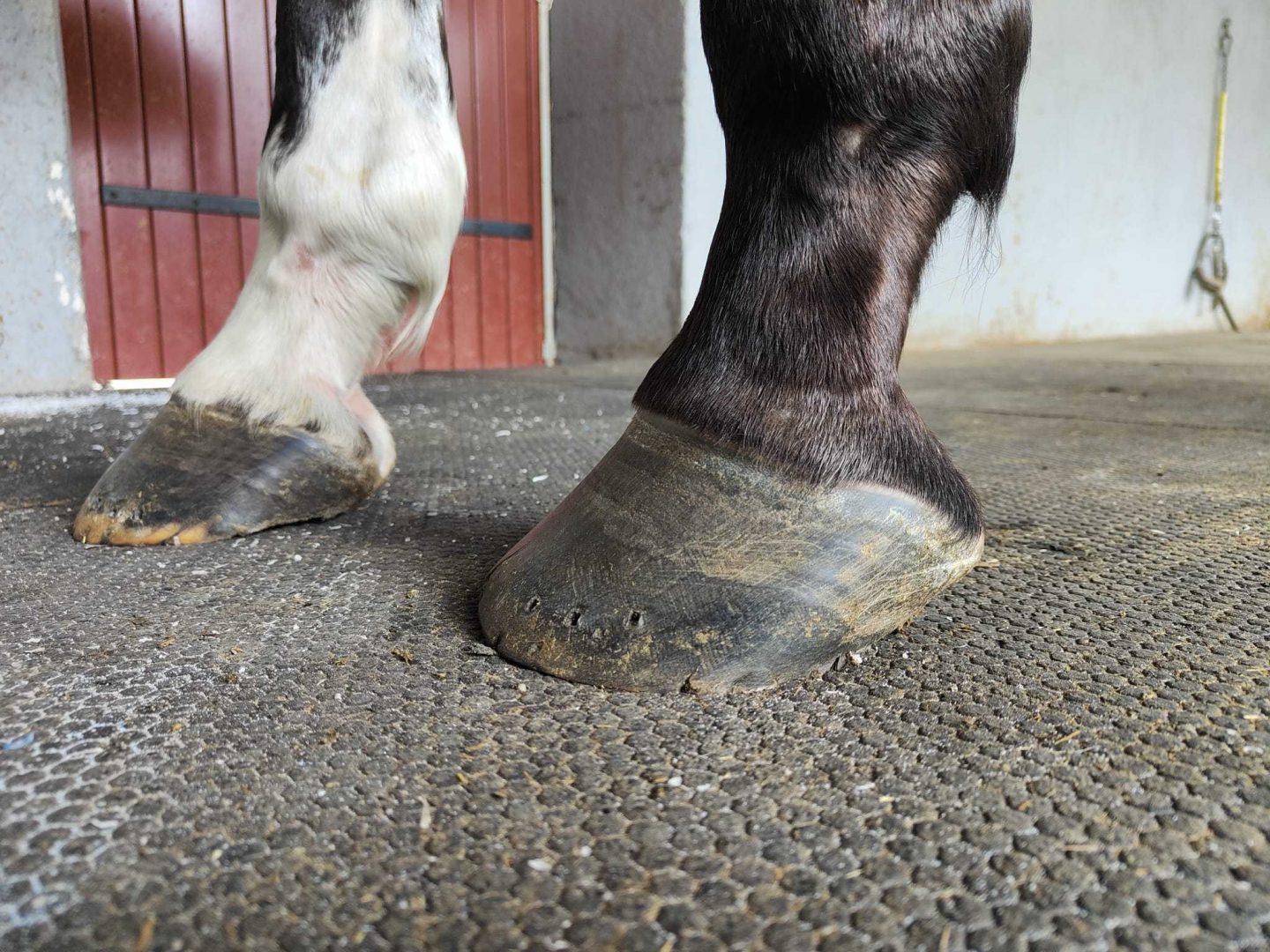Management in collaboration with equine veterinarian and farrier for the management of a horse with a navicular syndrome.
Anatomical reminder: The navicular apparatus of the horse
The navicular apparatus consists of the navicular bone (distal sesamoid bone), the sesamoid ligaments, the distal part of the deep digital flexor tendon (DDFT) and the navicular bursa.
The navicular bursa allows better sliding of the deep digital flexor tendon on the navicular bone.
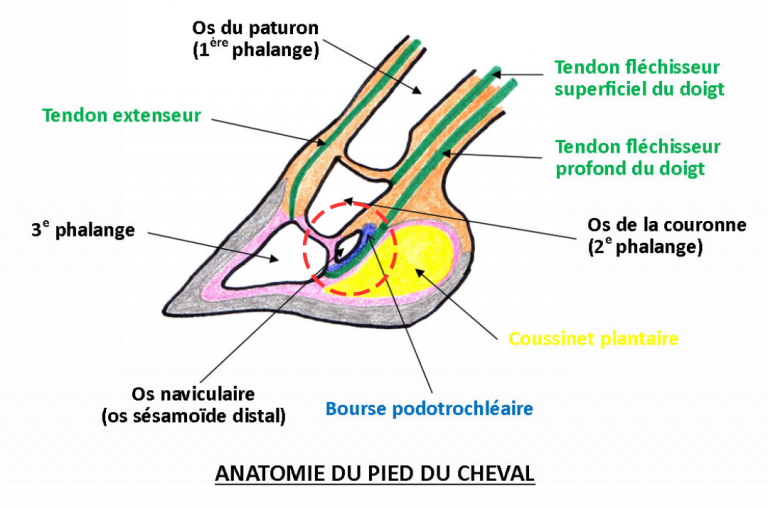
Damage to the navicular apparatus is a frequent cause of chronic lameness of the equine foot. Horses suffering from this type of lesion are then commonly defined as “navicular”.
Relieve the back part of the hoof
In the case of inflammation of the navicular bursa, one of the objectives of the equine veterinarian and the farrier is to relieve the heels of the hooves.
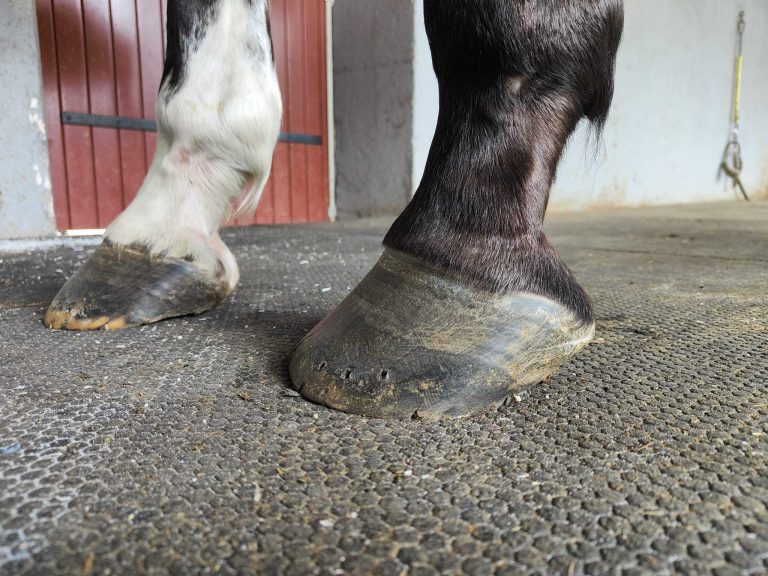
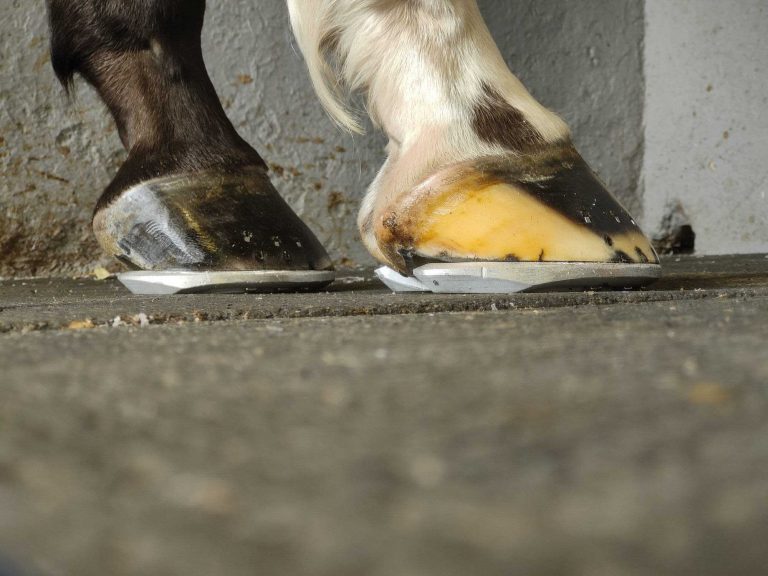
Before defining the possible farriery strategies to be put in place, clinical examinations are meticulously carried out by the professionals: verification of horse locomotion, taking orthopedic x-rays, static examinations, assessment of the condition of the feet.
The farrier/veterinarian collaboration makes it possible in this case to define the options to be considered to relieve the animal.
As for example in the case presented in this article, a light aluminum fitting has been adopted, with a pronounced application of a rolling and onions to increase the surface of support of the foot on the ground.
For this horse suffering from a navicular syndrome of the right forelimb, the use of an ACR 332 horseshoe was chosen by the medical team.
This full rolling iron on two thirds of its coverage facilitates anterior, posterior and collateral leverage effects.
The stresses on the collateral, distal and proximal ligaments are thus reduced as well as the tensions on the DDFT.
The enlarged heels of this fitting protect the sensitive hooves, and increase the support surface in the rear part of the foot. The sinking of the hoof in soft ground will also be limited.
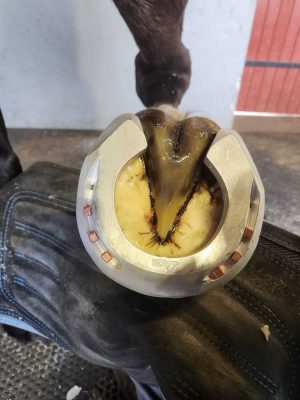
The plan of trimming was carried out following the reading of the orthopedic radiographs taken.
The toe trimming for this horse required a lot of work to rebalance the center of gravity.
Farriers and veterinarians aimed to have a toe angle greater than 45 degrees, in order to rebalance the load points of the foot. The horse thus relieves the pressure on the back part of the hoof and the recovery of height in the heel is encouraged.


The use of Metron technology is therefore particularly useful for the precise monitoring of this angle over time, the farrier explains to us:

“In the case of this inflammation of the foot, I tried at the first shoeing to reach an angle of at least 45° and to recover in heel height. This in agreement with the veterinarian.
When I took charge of this horse he really didn't have much heel, less than 1 cm.
The Metron is a great tool for this type of horse because as a farrier you can quickly be hesitant with feet like that. The tool allows us to go to the maximum of what we can do and it is ideal for seeing the follow-up.
I don't take shots at each fitting, but rather one out of two or three to be sure to keep the correct angles and see precisely the evolution of the hooves.”
For shoeing, the clips have been removed to move the shoe back, distribute the pressure points and thus relieve the horse's heels.

Farriery strategy
Fitting follow-up requires, in the case presented, a new horseshoes every 4 to 5 weeks. The objective is to maintain the interphalangeal axis as much as possible.
As long as it is well supported by the horse, the horseshoe remains unchanged (ACR 332).
In addition, this shoe is well suited to the phase return to work.


For this care, farrier and veterinarian, have anticipated a strategy to adopt in the event that the horse shows new signs of pain.
In this hypothesis, the addition of hoof pads with a silicone to increase the comfort of the equine has then already been studied.
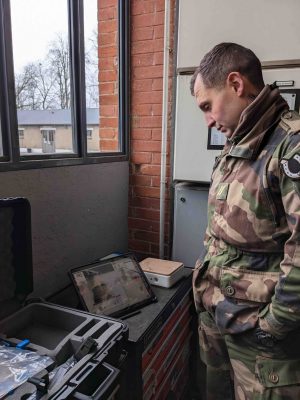
Inflammation of the navicular bursa, advices of farrier
“If I had to give any advice on the pitfalls to avoid in this type of treatment, it would be to not be afraid to go too far in correcting your feet. The risks are indeed the appearance of certain signs of discomfort for a few days.
But this strategy remains preferable in my opinion, because it makes it possible to resolve the problems of loads and foot balances.
In addition, if collaboration with a veterinarian and taking X-rays of the feet is possible, this will help you greatly for this type of shoeing, which is rare, but so interesting to perform.
All orthopedic fittings can be tricky to fit. This is worsened when working without the advice and analysis of a veterinarian in my opinion.
The exchanges between farriers and veterinarians allow access, I think, to the solutions best suited for the horse and the pathology that he meets, because everyone brings his experience in the field of expertise he masters.
Veterinary medicine and farriery are two very different professions and at the same time so complementary.
Their connection makes it possible to succeed in relieving, to treat and even to optimize certain horses. This is what I can conclude from my experience.
Many pathologies require being able to have an objective analysis of the internal tissues of the foot.
Despite all our experience in reading the limbs conformation and the hoof capsule we cannot actually see inside the hoof.
In these situations, veterinary examinations are again essential. Just like the exchanges between professionals, mandatory conditions, to succeed in adapting the best fitting to each case.”
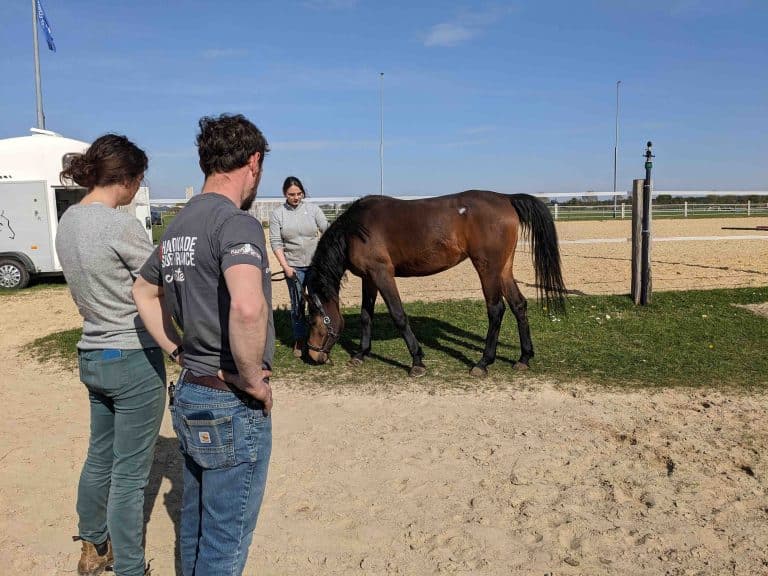
Inflammation of the navicular bursa, are there means of prevention?
Unfortunately, the means of prevention are difficult according to the farrier.
The causes of this type of inflammation can be very numerous and multifactorial: poorly adapted training, poor follow-up or maintenance of the feet.
Like for example a fitting that is too long for too long, bad limbs conformations etc.
Early detection by the farrier is a difficult task because we don't have the possibility of seeing at the inside of the animal's feet. It is very often the declaration of a lameness that will lead to veterinary examinations and which will make it possible to determine the origin of the symptom. In this case, the evil is already there.
“Apart from trying to do our job by taking the time to read, analyze and even sometimes decipher the hooves and distal part of the limbs, I don't think that there is a lot to do.
As farriers, we must try as much as possible to be in the ideal of the foot both in terms of trimming and shoeing.
On his side too , the rider can try to schedule his sessions wisely so as not to physically overstretch his equine partner. Particular attention to working conditions (grounds, condition of the feet, presence of asymmetries, etc.) contributes to the proper supervision of equines.
Without being exact sciences, food, general well-being etc. also have their roles in maintaining or degrading a horse.
Finally, we must keep in mind that farriery is one element among many others in the health of the feet and the locomotion of horses.” concludes the farrier.

